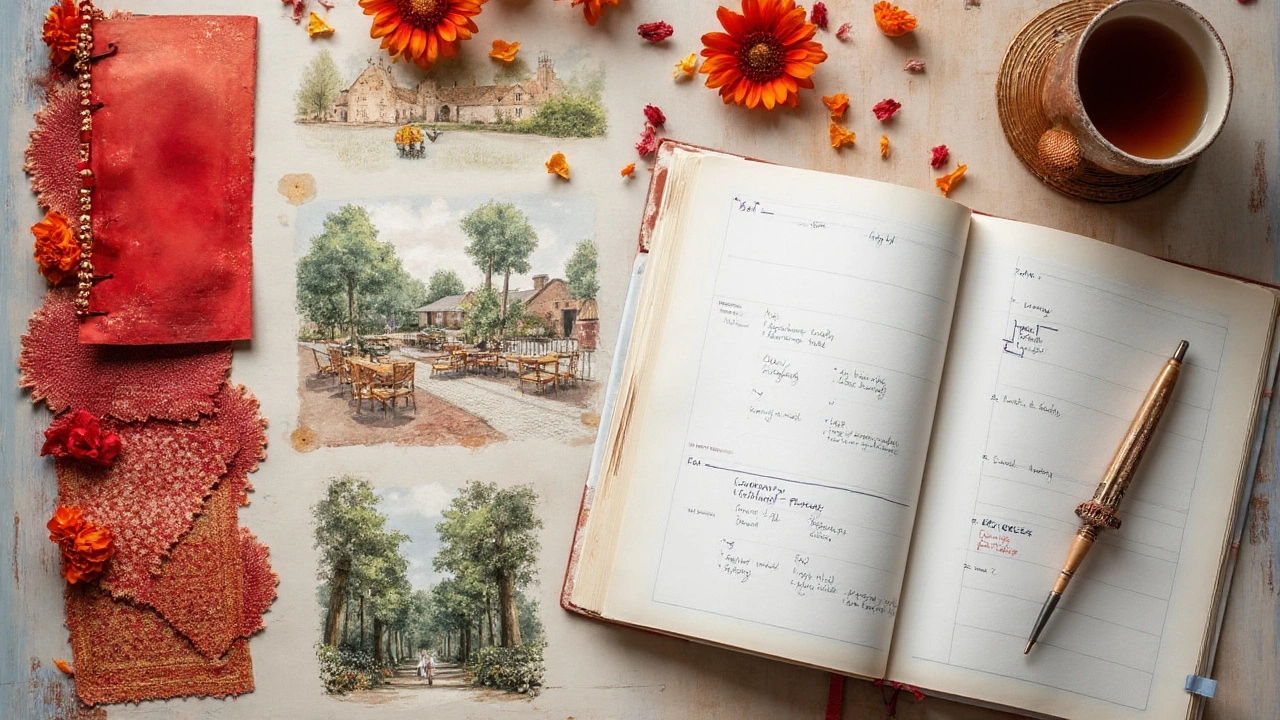
You clicked this because you want a straight answer: which month is not good for a wedding? Here’s the honest truth-there isn’t one universal “bad month.” What counts as “not good” depends on what you care about most: weather, price, guest turnout, daylight for photos, or cultural traditions. In the UK, certain months do carry more risk for rain and wind (hello October-November), some slam your budget (August Saturdays), and others clash with holidays or short daylight (late December, deep winter). I’ll show you how to judge the trade‑offs in minutes and help you lock a date you’ll feel confident about.
TL;DR: The Month Many Couples Avoid-and What Actually Matters
- There is no single worst month. In the UK, the riskiest for weather and daylight are October-November (storms, wind, rain) and December-January (short days, cold).
- Budget focus? Avoid August (peak pricing and demand), and late May bank holiday weekends if you’re price-sensitive. Off‑peak savings appear November-March.
- Guest attendance? Late December collides with Christmas travel costs; August collides with pricey holidays and childcare gaps; school half-terms can also dent turnout.
- Photos and light? December-January give very short daylight windows; June offers the longest but can be hot and squinty by midday.
- Superstition? In Britain, “Marry in May, rue the day” is a traditional rhyme. Most couples ignore it-May is often lovely.
A Simple Framework to Pick Your Date (and Spot Red Flags)
Use this quick, no‑nonsense process to judge if a month is “not good” for you:
- Set your top priority (pick one): lowest cost, best weather, best attendance, longest daylight/photos, or a meaningful date. This helps you ignore noise.
- Match priorities to months:
- Lowest cost: look at November-March (except New Year’s Eve). Weekdays add extra savings.
- Best weather odds: late May-early September. In the southeast, June-July tend to be warmer; August can be stormy.
- Guest attendance: avoid late December, mid‑August, and school holiday peaks. Consider travel time for your crowd.
- Daylight/photos: late April-August for long days; June gives the longest golden hour options.
- Check your location’s micro‑climate: Coastal Sussex can be windy; the West Country gets more rain; Scotland is cooler with later sunsets. Ask your venue what recent years looked like for your target month.
- Audit your venue’s backup: Is there an indoor plan that fits 100% of your guests comfortably if it pours? If not, avoid the stormier months or hire a proper, floored structure.
- Run the bank holiday and school holiday check: Compare your date with UK bank holidays and your local council’s school term dates. This affects travel costs and childcare.
- Price reality check: Ask three venues for the same date and for an equivalent off‑peak Friday. If the difference exceeds 20-30%, you’re in peak‑pricing territory.
Rule of thumb: If two or more of these are true-stormy season, no solid indoor backup, and high travel clashing-you’ll feel like your month is “not good.” Switch month or fix the risks.

UK Month-by-Month: Weather, Daylight, and Price Pressure
These patterns reflect southern UK norms, drawing on Met Office long‑term climate averages (1991-2020) and common venue pricing cycles. Local conditions vary, so use this as a guide and confirm with your venue and photographer.
| Month | Approx Daylight (mid‑month) | Avg High Temp (°C) | Rain/Wind Risk | Price Pressure | Notes |
|---|---|---|---|---|---|
| January | ~8-9 hours | ~8 | High | Off‑peak | Short days; travel disruption risk if icy; good savings and supplier availability. |
| February | ~9-10.5 hours | ~8 | High | Off‑peak | Still wintery; bright, crisp days possible; Valentine’s weekend premiums at some venues. |
| March | ~11-12.5 hours | ~11 | Medium | Shoulder | Unpredictable: daffodils and showers; lighter evenings after the clock change. |
| April | ~13-14.5 hours | ~13 | Medium | Shoulder | “April showers”; Easter holidays can affect travel and prices; blossoms are gorgeous. |
| May | ~15-16 hours | ~16 | Low-Medium | Shoulder → Peak on BH weekends | Two bank holidays most years; old superstition about May; often great for gardens. |
| June | ~16-16.5 hours | ~19 | Medium | Peak | Longest days; evening light is dreamy; pollen season for hay fever. |
| July | ~15-16 hours | ~22 | Medium | Peak | Warmest stretch; occasional heatwaves; school term ends late month. |
| August | ~14-15 hours | ~22 | Medium-High | Peak (highest) | Summer storms possible; most expensive; clashes with holidays and childcare. |
| September | ~12.5-13 hours | ~19 | Medium | Peak → Shoulder late month | Often settled and golden; kids back at school; earlier sunsets help timelines. |
| October | ~10-11 hours | ~15 | High | Shoulder | Autumn colour; frequent wind/rain; half‑term affects travel. |
| November | ~8.5-9.5 hours | ~11 | High | Off‑peak | Storm risk, early dark; bargains available; Bonfire Night around 5 Nov can add noise and traffic. |
| December | ~7.5-8 hours | ~8 | High | Off‑peak except NYE | Festive vibes; travel costs spike; shortest daylight; venues book out for parties. |
Evidence notes: The daylight ranges reflect southern England mid‑month averages. Temperature bands align with Met Office 1991-2020 climate normals. Storminess in October-November is a recurring pattern in UK weather summaries. For costs, UK venue pricing typically peaks June-September with a premium for August Saturdays; off‑peak is late autumn to early spring. Hitched’s UK Wedding Survey (2023) puts the average wedding cost around the £20k mark, with venue and catering as the largest line items-season and day of week significantly move that number.
So, which month is “not good”? For weather stability, couples often dodge October-November. For budgets, they dodge August. For attendance, they avoid late December. Your no‑go month is the one that clashes hardest with your top priority.
Scenarios, Trade‑offs, and How to Mitigate Risk
Here are real‑world situations and how I’d handle them.
- “We want outdoor vows in Sussex with no marquee.” Avoid October-March. Even April can be nippy on the coast. Target late May-July and still have a covered option for guests (heat or drizzle). Put parasols and water on your hire list for July.
- “We need to keep total spend under £15k.” Look at Fridays in November-March (skip New Year’s Eve). Consider a late ceremony with a reception‑only vibe. Ask venues for winter packages that include decor and basic lighting-it fills their off‑peak dates and reduces your hire list.
- “We care about photos and golden hour more than temperature.” Aim for late April, May, or September. The light is flattering, sunsets are early enough to catch between ceremony and dinner, and you avoid the squint-and-sweat of a July 1 p.m. ceremony.
- “We’ve got elderly guests and lots of kids.” Avoid August (cost, childcare gaps) and icy months (Jan-Feb). Choose late May, June, or September with step‑free access, nearby parking, and a short ceremony‑to‑reception transfer.
- “We’re tied to a specific date.” If that date sits in a risky month, fix the controllables: book a venue with a fully indoor plan that still feels special; choose earlier ceremonies in winter; add warm lighting, throws, and transport buffers.
Trade‑off cheat notes:
- August: Best for warm evenings; worst for budget and vendor availability. Book 12-18 months ahead if you must have a Saturday.
- October-November: Cosy colours and good rates; higher wind/rain risk. Choose venues with beautiful indoor ceremony spaces.
- December: Magical decor done for you; travel expensive; daylight is tiny. Bring timelines forward and add extra lighting for portraits.
- January-February: Biggest savings; risk of cancellations if icy. Provide clear transport plans and consider event insurance.
- May-June: Sweet spot for gardens and light; mind bank holidays and hay fever.
Mitigation tactics that actually work:
- Book real cover: If any part of your plan relies on the outdoors in a storm‑prone month, hire a floored marquee or stretch tent with sidewalls and proper heating.
- Flip your timeline: In winter, do photos before the ceremony or plan a first look. Aim to finish couple portraits by 3 p.m. in December.
- Add travel buffers: For winter dates, build 15-20 minutes of slack between segments, and keep ceremony and reception at the same venue if possible.
- Power and lighting: Dark months need more lighting than you think: festoons for outdoors, warm up‑lights inside, and spare power circuits for caterers and band.
- Insurance and contracts: Confirm force majeure and postponement terms. Event insurance is inexpensive compared to the risk of winter disruption.

Checklist, Cheat‑Sheet, and Mini‑FAQ
Quick checklist to decide if a month is “not good” for you:
- My top priority is clear (budget / weather / attendance / photos / date meaning).
- The venue has a full‑capacity indoor backup we actually like.
- Our date doesn’t clash with bank holidays, big sports, or school holidays for key guests.
- We’ve tested lighting and timeline for the daylight we’ll get that month.
- We’ve priced 1-2 off‑peak alternatives to understand the premium.
- Vendors confirmed they are comfortable with our month’s weather risks.
- Transport and accommodation are realistic for our guest list.
Fast rules of thumb:
- Want the longest golden hour? Late May to mid‑July. Schedule portraits for 7-8 p.m.
- Want peak savings? January, February, and mid‑November weekdays.
- Want predictable warmth without August chaos? Late June or early September.
- Hate wind? Avoid clifftops in October-November; coastal venues need solid wind plans.
- Venue says “wet‑weather plan”? Ask to see photos of it set for your guest count.
Mini‑FAQ
- Is May bad luck for weddings? It’s an old British superstition: “Marry in May and you’ll rue the day.” Most couples ignore it. Weather in May is often beautiful, with long daylight and blossoms.
- Which month has the worst UK weather for weddings? For wind and rain, October-November are typically bumpier. December-January add very short daylight and cold.
- What’s the cheapest month to get married? Usually January, February, and mid‑November. Expect the biggest discounts on weekdays and Sundays.
- Is August really more expensive? Yes. It’s school holidays plus prime summer. Venues, photographers, and bands charge peak rates, and availability is tight.
- Will insurance cover bad weather? Event insurance often covers extreme weather that prevents the event from going ahead, not light rain. Read the policy and your contracts carefully.
- How do we handle early sunsets in winter? Start ceremonies earlier, do a first look, plan indoor photo spots, and boost your lighting kit. Candles and warm tones photograph well.
Next steps
- If budget is king: Shortlist three off‑peak months and ask venues for package quotes for a Friday and a Sunday. Compare to one August Saturday quote to see the true premium.
- If weather is king: Ask your venue for their last three years of same‑month wedding galleries. You’ll see how the space performs in real rain and wind.
- If attendance is king: Send a save‑the‑month poll to VIPs with two options (e.g., late May vs early September). Pick the one with higher availability and lower travel costs.
- If photos are king: Share your date options with your photographer. They’ll flag daylight constraints and suggest the best ceremony time for your month.
Troubleshooting
- Booked October, now worried about storms: Upgrade your indoor plan, move group photos inside with flash, add a covered confetti tunnel at the entrance, and order clear umbrellas (they photograph well).
- Booked December, timeline is tight: Shift ceremony 60-90 minutes earlier, do a first look, add extra transport buffers, and prioritise key family photos to finish before dusk.
- Stuck with August but over budget: Change day (Thursday/Friday), trim guest count, choose a venue with inclusive decor/AV, and consider an afternoon tea or sharing‑style menu to reduce per‑head costs.
- Guests spread across the UK: Avoid bank holidays and half‑terms; pick a venue near major rail hubs; provide a coach from the nearest station to cut taxi faff and cost.
If you’re after a single, SEO‑friendly answer: most UK couples who worry about wind and rain tend to avoid October-November; those who worry about budget avoid August; and those who worry about turnout avoid late December. Your “not good” month is the one that fights your priority. Set the priority, pick the month that supports it, and plan a solid backup. That’s how you make any month work-even the one people call the worst month for wedding UK.


Comments
Post Comment